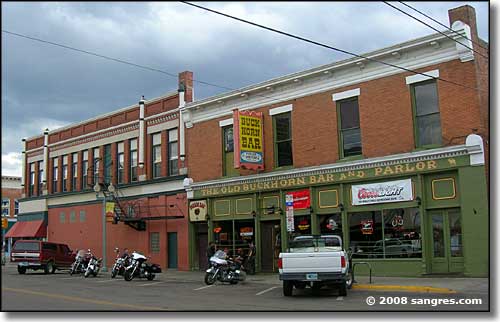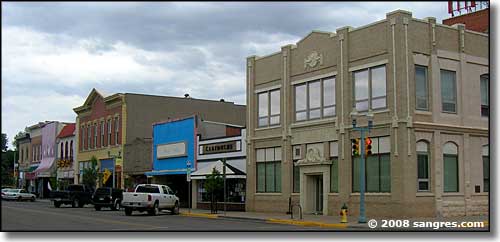
Laramie, Wyoming

This impressive edifice was right on the main street in Laramie

Laramie: just the name evokes visions of the old west, as it should. This is cowboy country, still. Laramie was founded in the mid-1860's as a tent city near the place where the Overland Trail stage route crossed the Laramie River. One story says the town was founded by three half-brothers: Ace Moyer, Con Moyer and "Big" Steve Long. Long served as Laramie's first marshall and together with his half-brothers, owned the Bucket of Blood Saloon. As homesteaders came into the bar from time to time, the brothers would harrass them, forcing most of them to sign over their homesteads to the brothers. Those settlers who didn't were killed. By October, 1868, it is estimated that Long alone had killed 13 men in this process, and 7 others had died under questionable circumstances. Then on October 28, 1868, the first Albany County sheriff (rancher NK Boswell) with some hand-picked men went into the Bucket of Blood and overwhelmed the three half-brothers. Then they marched the three prisoners up the street to an unfinished cabin and lynched them. Long had one request before he died: that he be allowed to take his boots off, because his mother had always told him he'd die with his boots on. This was pretty typical of early Wyoming, especially in the aftermath of the Civil War.
Laramie took its name from a French trapper named Jacques LaRamie who disappeared in the Laramie Mountains around 1818-1819. Most of us in the rest of America never heard of LaRamie, but the only mountain man/trapper with more landmarks named for him in Wyoming is Jim Bridger.
The Union Pacific Railroad was building westward to complete the first transcontinental line and reached Laramie in 1868. The first actual train rolled into town on May 10, 1868. By that time the tent city was being replaced by several more permanent structures and shortly after the train started making regular appearances, Laramie had stores, houses, churches and a school. In addition to the railroad yards, early industries included a brick yard, railroad tie treatment plant, rolling mills, a brewery, a slaughterhouse, a plaster mill and a glass-blowing plant.
The University of Wyoming was established in 1886 and Laramie was chosen as the site for it. Classes first opened in the fall of 1887. 1891 saw the University add an agricultural college and experiment station.
These days, Laramie is a major center for outdoor sports enthusiasts. The Medicine Bow National Forest is nearby and offers miles and miles of groomed cross-country ski, snowshoe and snowmobile trails. About 30 miles west of town (near Centennial in the Snowy Range) is the Snowy Range Ski Resort with 27 trails of downhill skiing and snowboarding. In the summer, nearly all of these trails (and more) are available for mountain biking. Trout fishing, hiking, camping, rock climbing, picnicking and whitewater rafting are also very popular in the area. And if you happen to be in town when the Wyoming Cowboys are playing a home game...






Zip Codes: 82070-82073
Latitude: 41.3129°N
Longitude: 105.9746°W
Elevation: 7,165'
Education:
High School or Higher: 94.0%
Bachelor's Degree or Higher: 46.7%
Graduate or Professional Degree: 19.6%
2011 Cost of Living Index for Laramie: 90.4
Median Resident Age: 25.3 Years
Estimated Median Household Income: $37,140
Estimated Median Home Value: $200,550
Population Density: 2,486 People per Square Mile
Major Industries:
Educational Services, Health Care, Lodging & Food Services, Construction, Government, Professional Services, Social Services, Finance & Insurance Services, Waste Management Services
Unemployed (March 2011): 4.2%
Population Demographics: 2010
| Total Population | 30,816 |
| Males | 16,024 |
| Females | 14,792 |
| Population by Age | |
| Under 18 | 4,908 |
| 18 & over | 25,908 |
| 20-24 | 7,441 |
| 25-34 | 5,450 |
| 35-49 | 3,981 |
| 50-64 | 4,071 |
| 65 & over | 2,323 |
| Population by Ethnicity | |
| Hispanic or Latino | 2,840 |
| Non Hispanic or Latino | 27,976 |
| Population by Race | |
| White | 27,571 |
| African-American | 407 |
| Asian | 996 |
| Native American | 207 |
| Hawaiian or Pacific Islander | 20 |
| Other | 764 |
| Two or more | 851 |
